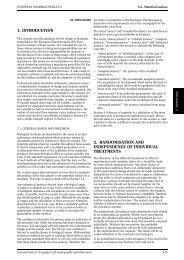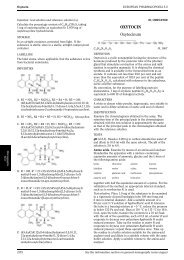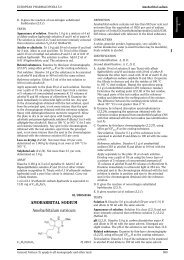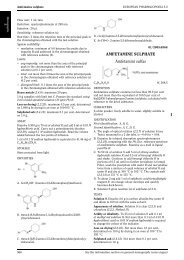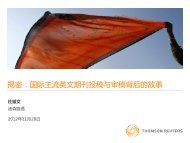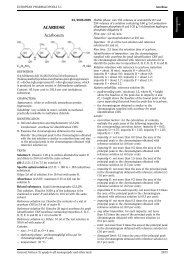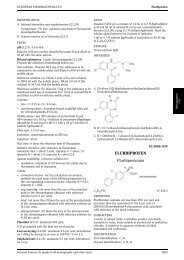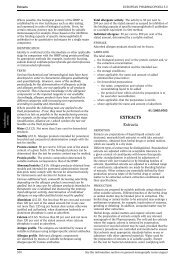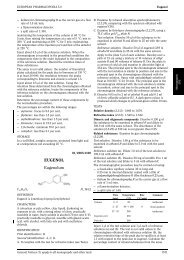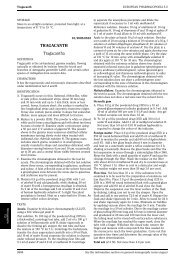ANTHRAX SPORE VACCINE (LIVE) FOR VETERINARY USE ...
ANTHRAX SPORE VACCINE (LIVE) FOR VETERINARY USE ...
ANTHRAX SPORE VACCINE (LIVE) FOR VETERINARY USE ...
You also want an ePaper? Increase the reach of your titles
YUMPU automatically turns print PDFs into web optimized ePapers that Google loves.
EUROPEAN PHARMACOPOEIA 5.0 Aujeszky’s disease vaccine (inactivated) for pigs<br />
01/2005:0441<br />
<strong>ANTHRAX</strong> <strong>SPORE</strong> <strong>VACCINE</strong> (<strong>LIVE</strong>)<br />
<strong>FOR</strong> <strong>VETERINARY</strong> <strong>USE</strong><br />
Vaccinum anthracis vivum<br />
ad usum veterinarium<br />
DEFINITION<br />
Anthrax spore live vaccine for veterinary use consists of a<br />
suspension of live spores of an attenuated, non-capsulated<br />
strain of Bacillus anthracis.<br />
PRODUCTION<br />
The strain used is either: not lethal to the guinea-pig or the<br />
mouse; or lethal to the guinea-pig but not to the rabbit;<br />
or lethal to some rabbits. B. anthracis is grown in an<br />
appropriate medium. At the end of growth the spores are<br />
suspended in a stabilising solution and counted. The vaccine<br />
may contain an adjuvant.<br />
IDENTIFICATION<br />
B. anthracis present in the vaccine is identified by means of<br />
morphological and serological tests, culture and biochemical<br />
tests.<br />
TESTS<br />
Safety. Carry out the test on one of the species of animals<br />
for which the vaccine is intended. If the vaccine is intended<br />
for several species, including the goat, carry out the test<br />
on goats. Administer subcutaneously or intradermally to<br />
each of 2 animals, of the minimum age recommended for<br />
vaccination and having no antibodies against B. anthracis,<br />
twice the dose stated on the label for the species used and<br />
observe the animals for 14 days. No abnormal systemic<br />
reaction is produced but a local reaction may occur at the<br />
site of injection. The severity of the local reaction may vary<br />
according to the strain of the spores and the adjuvants used<br />
in the preparation, but necrosis does not occur.<br />
Spore count. The number of live spores determined by plate<br />
countisnotlessthan80percentofthatstatedonthelabel.<br />
Bacterial and fungal contamination. Carryoutthetest<br />
by microscopic examination and by inoculation of suitable<br />
media. The vaccine does not contain contaminating bacteria<br />
or fungi.<br />
POTENCY<br />
For a strain of B. anthracis which is not lethal to the<br />
guinea-pig or the mouse, the test may be carried out in<br />
guinea-pigs. For a strain which is lethal to the guinea-pig<br />
but not to the rabbit, the test may be carried out in rabbits.<br />
For a strain which is lethal to some rabbits, carry out the<br />
test in sheep.<br />
If the test is carried out in guinea-pigs or in rabbits, use<br />
10 healthy animals (group a). Inject subcutaneously or<br />
intradermally into each animal 1/10 of the smallest dose<br />
of the vaccine stated on the label for sheep. Observe the<br />
animals for 21 days. If more than 2 animals die from<br />
non-specific causes, repeat the test. Use as controls 3 animals<br />
of the same species and of the same origin.<br />
If the test is carried out in sheep, use 5 healthy animals<br />
(group b). Inject subcutaneously or intradermally into each<br />
animal 1/10 of the smallest dose of the vaccine stated on<br />
thelabelforsheep.Observetheanimalsfor21days.Useas<br />
controls 3 sheep of the same origin. Inject subcutaneously<br />
into each vaccinated animal of group (a) or group (b) at least<br />
100 MLD and into each control animal 10 MLD of a strain of<br />
B. anthracis pathogenic for the species of animal used in the<br />
test. Observe all the animals for 10 days. All the vaccinated<br />
animals survive and all the controls die from anthrax during<br />
the observation period. If a vaccinated animal dies after the<br />
challenge, repeat the test. If in the second test a vaccinated<br />
animal dies, the vaccine fails the test.<br />
LABELLING<br />
The label states:<br />
— the strain used for preparation of the vaccine,<br />
— the number of viable spores per millilitre.<br />
01/2005:0744<br />
AUJESZKY’S DISEASE <strong>VACCINE</strong><br />
(INACTIVATED) <strong>FOR</strong> PIGS<br />
Vaccinum morbi Aujeszkyi ad suem<br />
inactivatum<br />
DEFINITION<br />
Aujeszky’s disease vaccine (inactivated) for pigs consists<br />
of a suspension of an appropriate strain of Aujeszky’s<br />
disease virus inactivated without affecting its immunogenic<br />
properties or a suspension of an inactivated fraction of the<br />
virus having adequate immunogenic properties.<br />
PRODUCTION<br />
The virus strain is grown in suitable cell cultures (5.2.4).<br />
The viral suspension is harvested and inactivated; it may be<br />
treated to fragment the virus and the viral fragments may<br />
be purified and concentrated.<br />
The test for inactivation is carried out using two passages in<br />
thesametypeofcellcultureasthatusedintheproduction<br />
of the vaccine or cells shown to be at least as sensitive. The<br />
quantity of inactivated virus used in the test is equivalent to<br />
not less than twenty-five doses of the vaccine. No live virus<br />
is detected.<br />
Suitable adjuvants and antimicrobial preservatives may be<br />
added. The vaccine may be freeze-dried.<br />
CHOICE OF <strong>VACCINE</strong> COMPOSITION<br />
The vaccine is shown to be satisfactory with respect to safety<br />
and immunogenicity. The following tests may be used during<br />
demonstration of safety (5.2.6) and efficacy (5.2.7).<br />
Safety<br />
A. A test is carried out in each category of animals for which<br />
the vaccine is intended (sows, fattening pigs). The animals<br />
used do not have antibodies against Aujeszky’s disease<br />
virus or against a fraction of the virus. Two doses of<br />
vaccine are injected by a recommended route into each<br />
of not fewer than ten animals. After 14 days, one dose of<br />
vaccine is injected into each of the animals. The animals<br />
are observed for a further 14 days. No abnormal local or<br />
systemic reaction is produced during the 28 days of the<br />
test.Ifthevaccineisintendedforuseinpregnantsows,<br />
for the test in this category of animal the observation<br />
period is prolonged up to farrowing and any effects on<br />
gestation or the offspring are noted.<br />
B. The animals used in the test for immunogenicity are<br />
also used to evaluate safety. The rectal temperature<br />
of each vaccinated animal is measured at the time of<br />
vaccination and 6 h, 24 h and 48 h later. No animal shows<br />
a temperature rise greater than 1.5 °C and the number of<br />
animals showing a temperature greater than 41 °C does<br />
not exceed 10 per cent of the group. No other systemic<br />
reactions (for example, anorexia) are noted. At slaughter,<br />
GeneralNotices(1)applytoallmonographsandothertexts 715
Aujeszky’s disease vaccine (inactivated) for pigs EUROPEAN PHARMACOPOEIA 5.0<br />
the injection site is examined for local reactions. No<br />
abnormal local reactions attributable to the vaccine are<br />
produced.<br />
C. The animals used for field trials are also used to evaluate<br />
safety. A test is carried out in each category of animals<br />
for which the vaccine is intended (sows, fattening pigs).<br />
Not fewer than three groups each of not fewer than<br />
twenty animals are used with corresponding groups of<br />
not fewer than ten controls. The rectal temperature<br />
of each vaccinated animal is measured at the time of<br />
vaccinationand6h,24hand48hlater.Noanimalshows<br />
a temperature rise greater than 1.5 °C and the number of<br />
animals showing a temperature greater than 41 °C does<br />
not exceed 25 per cent of the group. At slaughter, the<br />
injection site is examined for local reactions. No abnormal<br />
local reactions attributable to the vaccine are produced.<br />
Immunogenicity. Not fewer than ten fattening pigs of the<br />
age recommended for vaccination and which do not have<br />
antibodies against Aujeszky’s disease virus or against a<br />
fractionofthevirusareused.Thebodymassofnoneofthe<br />
pigs differs from the average body mass of the group by more<br />
than 20 per cent. Each pig is vaccinated according to the<br />
recommended schedule and by a recommended route. Five<br />
similar pigs are used as controls. At the end of the fattening<br />
period (80 kg to 90 kg), each pig is weighed and then<br />
challenged by the intranasal route with a suitable quantity of<br />
a virulent strain of Aujeszky’s disease virus (challenge with<br />
at least 106 CCID50 of a virulent strain having undergone<br />
not more than three passages and administered in not less<br />
than 4 ml of diluent has been found to be satisfactory). The<br />
titreofchallengevirusisdeterminedinswabstakenfrom<br />
the nasal cavity of each animal daily from the day before<br />
challenge until virus is no longer detected. Each animal is<br />
weighed 7 days after challenge or at the time of death if this<br />
occurs earlier and the average daily gain is calculated as a<br />
percentage. For each group (vaccinated and controls), the<br />
average of the average daily gains is calculated. The vaccine<br />
complies with the test if:<br />
— all the vaccinated pigs survive and the difference between<br />
theaveragesofthedailygainsforthetwogroupsisnot<br />
less than 1.5,<br />
— the geometrical mean titres and the duration of excretion<br />
of the challenge virus are significantly lower in vaccinates<br />
than in controls.<br />
The test is not valid unless all the control pigs display signs<br />
of Aujeszky’s disease and the average of their daily gains<br />
is less than −0.5.<br />
If the vaccine is intended for use in sows for the passive<br />
protection of piglets, the suitability of the strain for<br />
this purpose may be demonstrated by the following<br />
method. Eight sows which do not have antibodies against<br />
Aujeszky’s disease virus or against a fraction of the virus<br />
are vaccinated according to the recommended schedule and<br />
by a recommended route; four sows are kept as controls.<br />
Thepigletsfromthesowsarechallengedwithasuitable<br />
quantity of a virulent strain of Aujeszky’s disease virus at 6<br />
to 10 days of age. The piglets are observed for 21 days. The<br />
vaccine is satisfactory if not less than 80 per cent protection<br />
against mortality is found in the piglets from the vaccinated<br />
sows compared to those from the control sows. The test is<br />
not valid if the average number of piglets per litter for each<br />
groupislessthansix.<br />
BATCH TESTING<br />
The test described under Potency is not necessarily carried<br />
out for routine testing of batches of vaccine. It is carried out<br />
for a given vaccine, on one or more occasions, as decided by<br />
or with the agreement of the competent authority; where<br />
the test is not carried out a suitable, validated, alternative<br />
test is carried out, the criteria for acceptance being set with<br />
reference to a batch of vaccine that has given satisfactory<br />
results in the test described under Potency.<br />
IDENTIFICATION<br />
In animals having no antibodies against Aujeszky’s disease<br />
virus or against a fraction of the virus, the vaccine stimulates<br />
the production of specific antibodies against Aujeszky’s<br />
diseasevirusorthefractionofthevirususedinthe<br />
production of the vaccine.<br />
TESTS<br />
Safety. Inject two doses of the vaccine by a recommended<br />
route into each of not fewer than two pigs of the minimum<br />
age recommended for vaccination and having no antibodies<br />
against Aujeszky’s disease virus or against a fraction of<br />
the virus. Observe the animals for 14 days and then inject<br />
onedoseofthevaccineintoeachpiglet.Observetheanimals<br />
forafurther14days.Noabnormallocalorsystemicreaction<br />
occurs during the 28 days of the test.<br />
Inactivation. Wherever possible, carry out a suitable test<br />
for residual infectious Aujeszky’s disease virus using two<br />
passages in the same type of cell culture as used in the<br />
production of the vaccine or cells shown to be at least<br />
as sensitive. Otherwise, inject one dose of the vaccine<br />
subcutaneously into each of five healthy non-immunised<br />
rabbits. Observe the animals for 14 days after the injection.<br />
No abnormal reaction (in particular a local rash) occurs. If<br />
the vaccine strain is not pathogenic for the rabbit, carry out<br />
the test in two sheep.<br />
Extraneous viruses. On the pigs used for the safety test<br />
carry out tests for antibodies. The vaccine does not stimulate<br />
the formation of antibodies, other than those against<br />
Aujeszky’s disease virus, against viruses pathogenic for pigs<br />
or against viruses that could interfere with the diagnosis<br />
of infectious diseases of pigs (including the viruses of the<br />
pestivirus group).<br />
Sterility. The vaccine complies with the test for sterility<br />
prescribed in the monograph on Vaccines for veterinary<br />
use (0062).<br />
POTENCY<br />
Use not fewer than five pigs each weighing 15 kg to 35 kg<br />
and which do not have antibodies against Aujeszky’s disease<br />
virus or against a fraction of the virus. The body mass of<br />
none of the pigs differs from the average body mass of the<br />
group by more than 25 per cent. Administer to each pig<br />
by a recommended route one dose of the vaccine. Use five<br />
similarpigsascontrols.Threeweekslaterweigheachpig<br />
and then challenge by the intranasal route with a suitable<br />
quantity of a virulent strain of Aujeszky’s disease virus.<br />
Weigh each animal 7 days after challenge or at the time<br />
of death if this occurs earlier and calculate the average<br />
daily gain as a percentage. For each group (vaccinated and<br />
controls), calculate the average of the average daily gains.<br />
Thevaccinepassesthetestifthevaccinatedpigssurviveand<br />
thedifferencebetweentheaveragesofthedailygainsforthe<br />
two groups is not less than 1.1. The test is not valid unless<br />
allthecontrolpigsdisplaysignsofAujeszky’sdiseaseand<br />
theaverageoftheirdailygainsislessthan−0.5.<br />
LABELLING<br />
The label states:<br />
— whether the vaccine strain is pathogenic for the rabbit,<br />
— whether the vaccine is a whole-virus vaccine or a subunit<br />
vaccine.<br />
716 See the information section on general monographs (cover pages)



